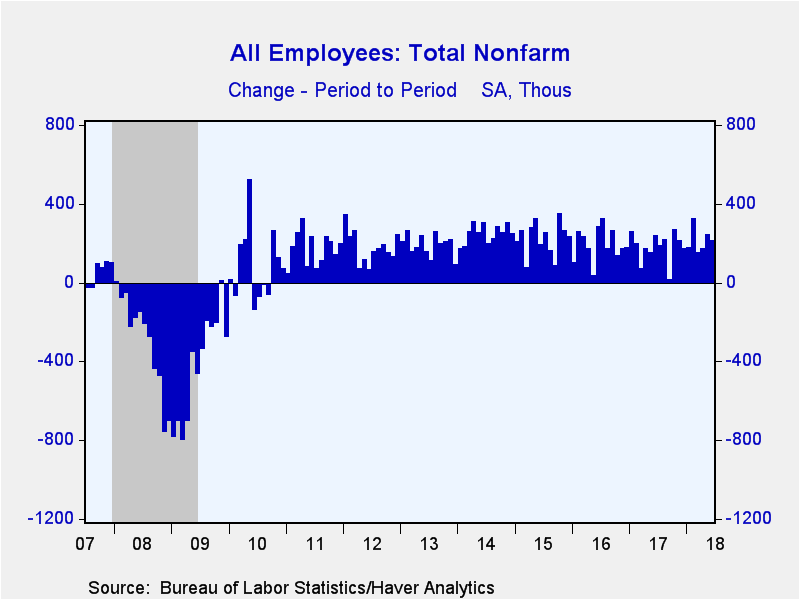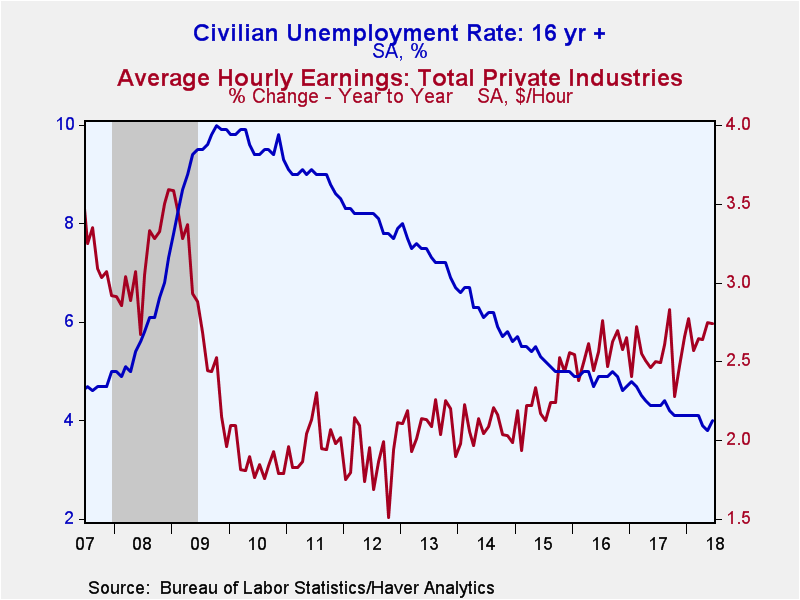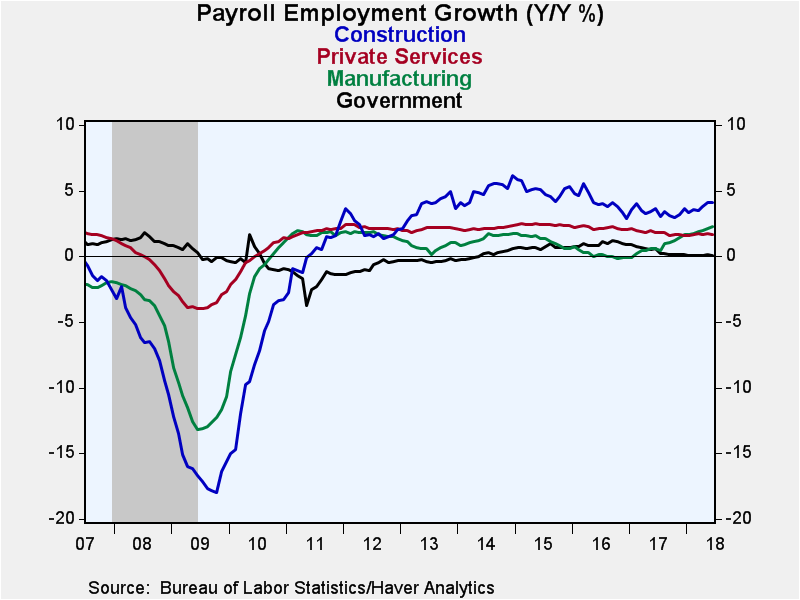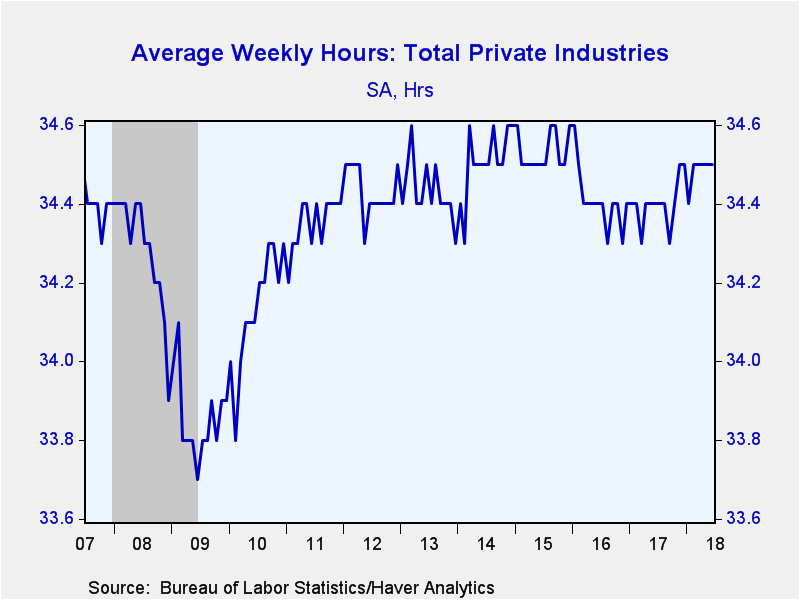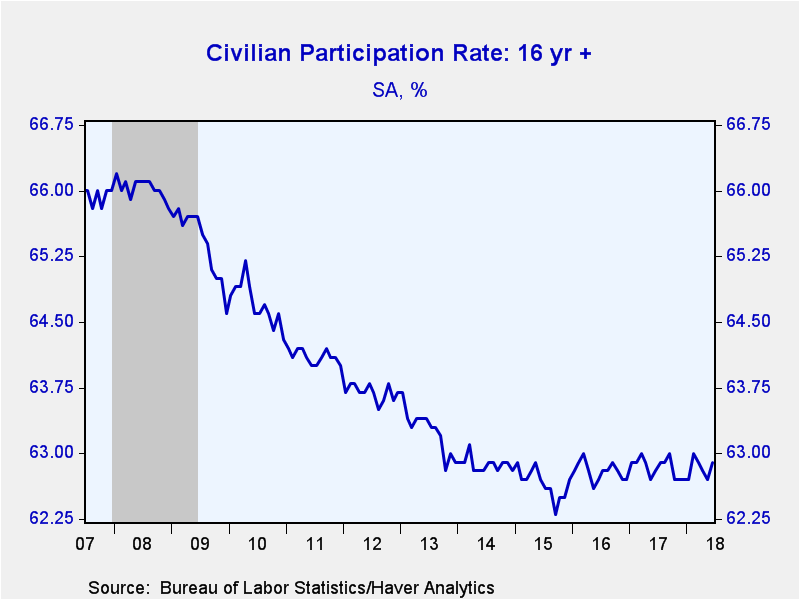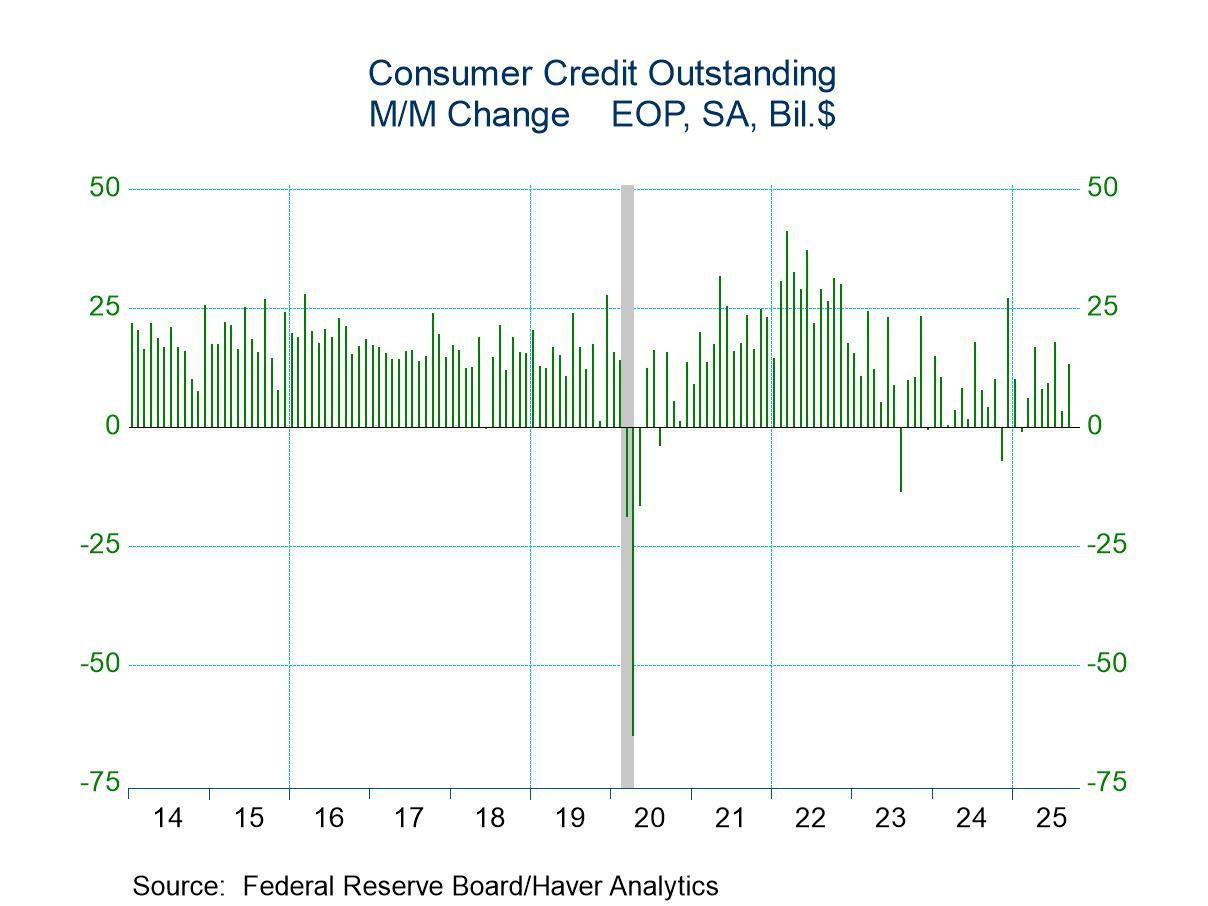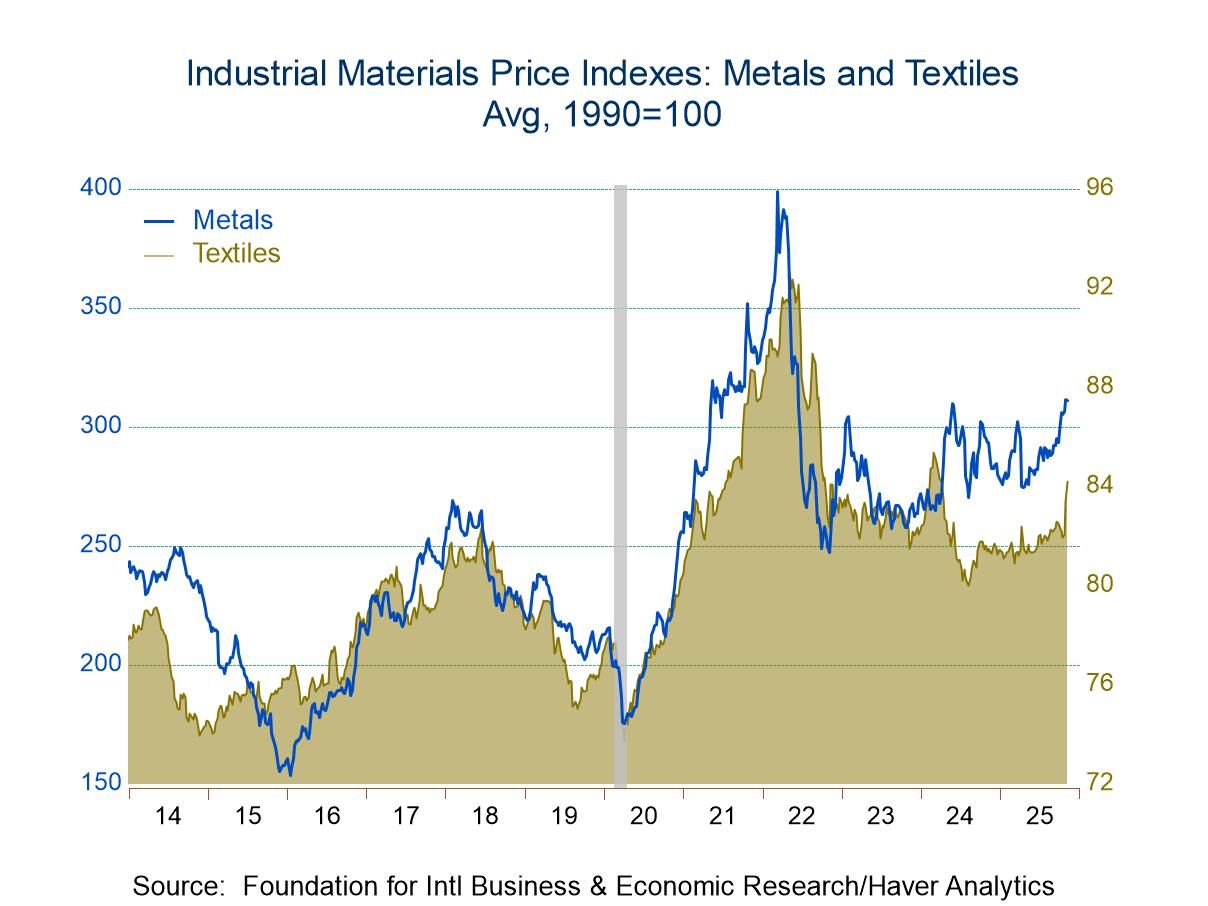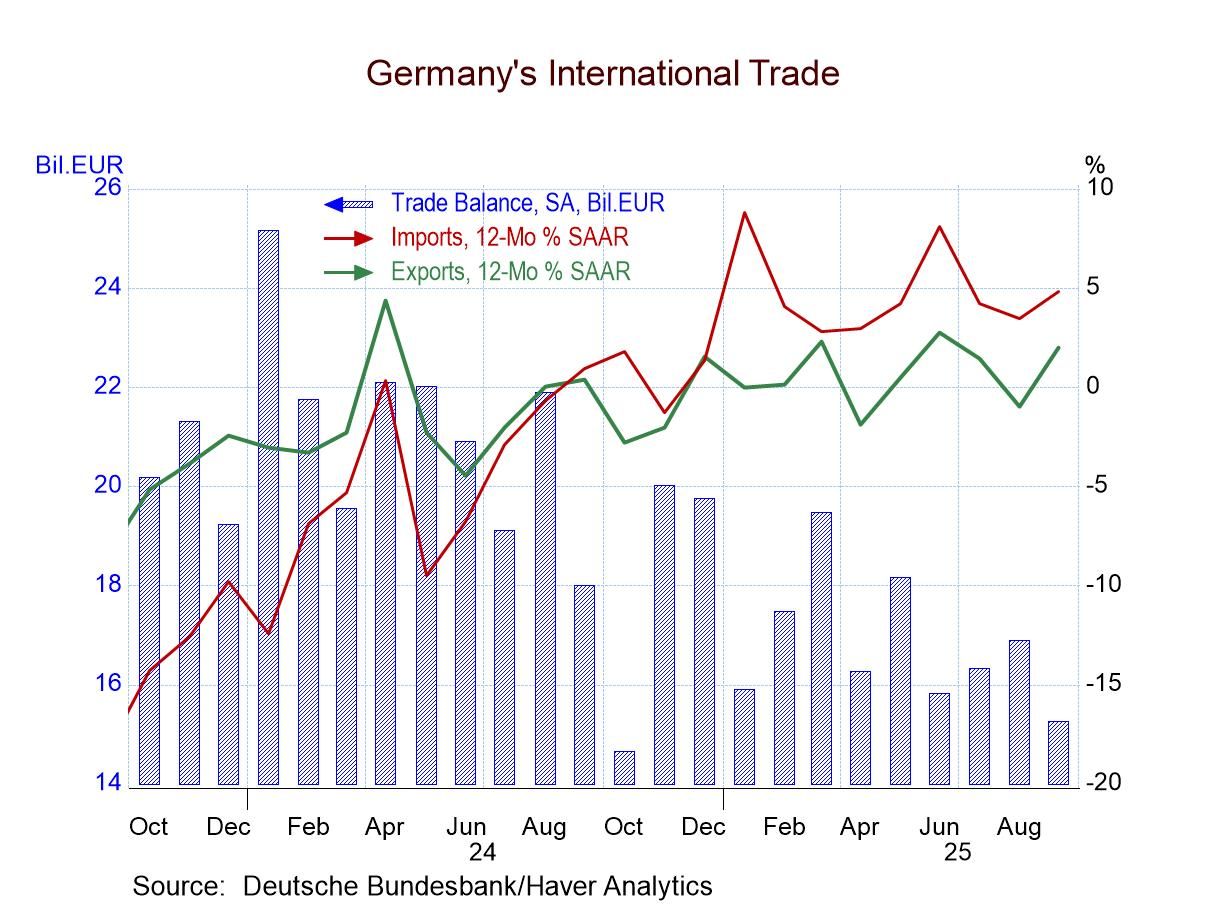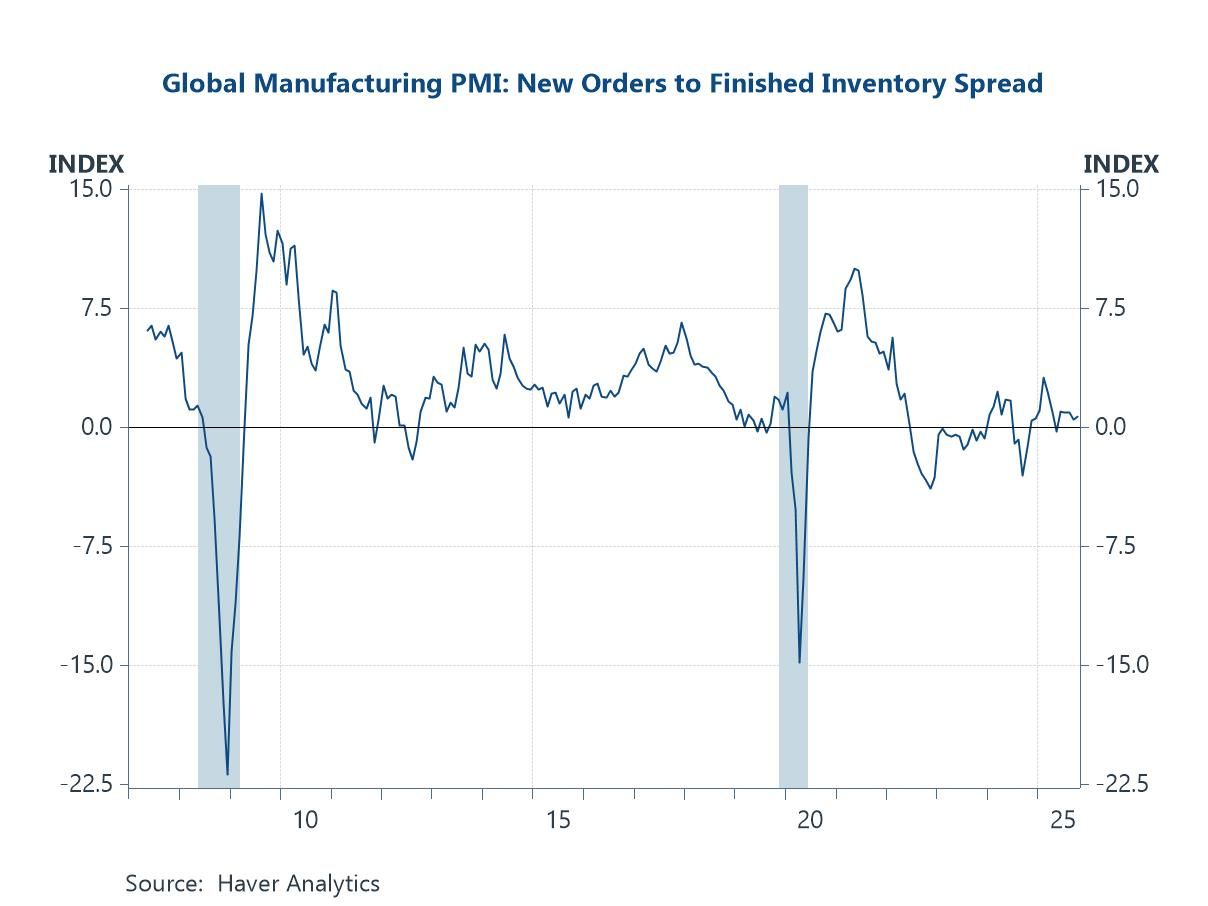 Global| Jul 06 2018
Global| Jul 06 2018U.S. Nonfarm Payrolls Rise Firmly; Jobless Rate Increases; Wages Gain Moderately
by:Tom Moeller
|in:Economy in Brief
Summary
The job market remained firm during June. Nonfarm payrolls increased 213,000 (1.6% y/y) following a 244,000 May rise and a 175,000 April gain. Together, payrolls during these two months were revised up by 37,000. A 191,000 rise in [...]
The job market remained firm during June. Nonfarm payrolls increased 213,000 (1.6% y/y) following a 244,000 May rise and a 175,000 April gain. Together, payrolls during these two months were revised up by 37,000. A 191,000 rise in employment was expected in the Action Economics Forecast Survey. Strength in employment has generated an improvement in wages. Average hourly earnings increased 0.2% (2.7% y/y) which followed an unrevised 0.3% rise. A 0.3% rise had been anticipated.
The unemployment rate rose to 4.0% due to a surge in the labor force. Expectations had been for 3.8%. The total unemployment rate, including those marginally attached and working part-time for economic reasons, rose to 7.8%.
From the payroll employment survey, the 213,000 job increase roughly equaled a 215,000 average during the first six months of the year. It was up, however, versus last year's 198,000 average. Factory sector employment increased 36,000 (2.3% y/y), the largest increase in six months and up versus last year's 17,000 average gain. Jobs in the construction sector rose a diminished 13,000 (3.9% y/y). Mining sector employment rose 4,900 (9.4% y/y) and roughly equaled last year's rate of gain, which compared to declines during 2016 and 2015.
Private service-producing employment increased 149,000 (1.7% y/y), up slightly from last year's 138,000 average. The gain was led by a 54,000 increase (2.0% y/y) in education & health services which was the largest increase since July of last year. The 50,000 gain (2.6% y/y) in professional & business service sector employment included a 9,300 increase (3.1% y/y) in temporary help jobs. Employment in the leisure & hospitality sector rose 25,000 (1.6% y/y), about the same as it did in May. Financial activities employment improved 8,000 (1.5% y/y) after a 17,000 increase, but information sector hiring held steady (-1.0% y/y) for the second straight month. Employment in trade, transportation & utilities eased 4,000 (+1.1% y/y) after a 47,000 increase.
Employment in the government sector improved 11,000 (0.0% y/y) after a 5,000 rise. Local government employment increased 13,000 (0.6% y/y), nearly triple last year's average monthly increase. Jobs with state governments held steady (-1.2% y/y) following two straight months of decline. Federal government employment declined 2,000 (-0.6% y/y), about as it did on a monthly basis during 2017.
The 0.2% increase in average hourly earnings reflected a 0.2% rise in private production & non-supervisory earnings. Here, the 2.7% y/y increase matches the strongest gain since mid-2009. Earnings in the financial sector increased 4.6% y/y while leisure & hospitality sector pay rose 3.4% y/y. Information services earnings rose 3.1% y/y. Education & health services earnings increased 2.9% y/y and professional & business service sector pay rose 2.7% during the last twelve months. Mining & logging sector earnings rose 2.0% y/y. Construction sector earnings increased 2.9% y/y compared to a 1.7% y/y rise in factory sector earnings.
The length of the average workweek held steady at 34.5 hours, where it's been for some time. The mining & logging workweek rose to 46.5 hours and the factory sector workweek improved to 40.9 hours. The construction sector workweek eased to 39.3 hours. In the private service sector, the length of the average workweek lengthened to 33.4 hours and equaled the expansion high. The financial activities workweek held steady at 37.6 hours and professional & business services hours remained at 36.2 hours. Information services hours held at 35.9 hours. Education & health services hours extended to an expansion high of 33.0, while leisure & hospitality hours improved to 26.2.
From the household employment survey, the rise in the unemployment rate to 4.0% reflected a 102,000 increase (1.5% y/y) in employment and a 601,000 labor force rise (1.2% y/y). It was the strongest monthly gain since February. The labor force participation rate nudged up to 62.9%, but remained roughly at the same level since early-2016. The number of persons not in the labor force eased 0.4% m/m (+0.8% y/y), the first decline since February.
By educational attainment, the unemployment rate for those with less than a high school diploma stood at 5.5% compared to 4.2% for high school graduates, but no college. Those with some college but less than a bachelors degree were 3.3% unemployed, while college graduates were 2.3% without work.
The 12.6% teenage unemployment rate compared to 7.4% for those aged 20-24 years old. Individuals who were over 25 were 3.3% unemployed and workers over age 55 were 3.1% without work.
The labor market data are contained in Haver's USECON database. Detailed figures are in the EMPL and LABOR databases. The expectations figures are in the AS1REPNA database.
| Employment: (SA, M/M Change, 000s) | Jun | May | Apr | Jun Y/Y | 2017 | 2016 | 2015 |
|---|---|---|---|---|---|---|---|
| Payroll Employment | 213 | 244 | 175 | 1.6% | 1.6% | 1.8% | 2.1% |
| Previous Estimate | -- | 223 | 159 | -- | -- | -- | -- |
| Manufacturing | 36 | 19 | 28 | 2.3 | 0.7 | 0.1 | 1.2 |
| Construction | 13 | 29 | 16 | 3.9 | 2.4 | 4.1 | 5.0 |
| Private Service-Producing | 149 | 188 | 122 | 1.7 | 1.8 | 2.2 | 2.4 |
| Government | 11 | 5 | 1 | 0.0 | 0.4 | 0.9 | 0.7 |
| Average Weekly Hours - Private Sector | 34.5 | 34.5 | 34.5 | 34.4 | 34.4 | 34.4 | 34.5 |
| Private Sector Average Hourly Earnings (%) | 0.2 | 0.3 | 0.2 | 2.7 | 2.5 | 2.6 | 2.3 |
| Unemployment Rate (%) | 4.0 | 3.8 | 3.9 | 4.3 | 4.4 | 4.9 | 5.3 |
Tom Moeller
AuthorMore in Author Profile »Prior to joining Haver Analytics in 2000, Mr. Moeller worked as the Economist at Chancellor Capital Management from 1985 to 1999. There, he developed comprehensive economic forecasts and interpreted economic data for equity and fixed income portfolio managers. Also at Chancellor, Mr. Moeller worked as an equity analyst and was responsible for researching and rating companies in the economically sensitive automobile and housing industries for investment in Chancellor’s equity portfolio. Prior to joining Chancellor, Mr. Moeller was an Economist at Citibank from 1979 to 1984. He also analyzed pricing behavior in the metals industry for the Council on Wage and Price Stability in Washington, D.C. In 1999, Mr. Moeller received the award for most accurate forecast from the Forecasters' Club of New York. From 1990 to 1992 he was President of the New York Association for Business Economists. Mr. Moeller earned an M.B.A. in Finance from Fordham University, where he graduated in 1987. He holds a Bachelor of Arts in Economics from George Washington University.


